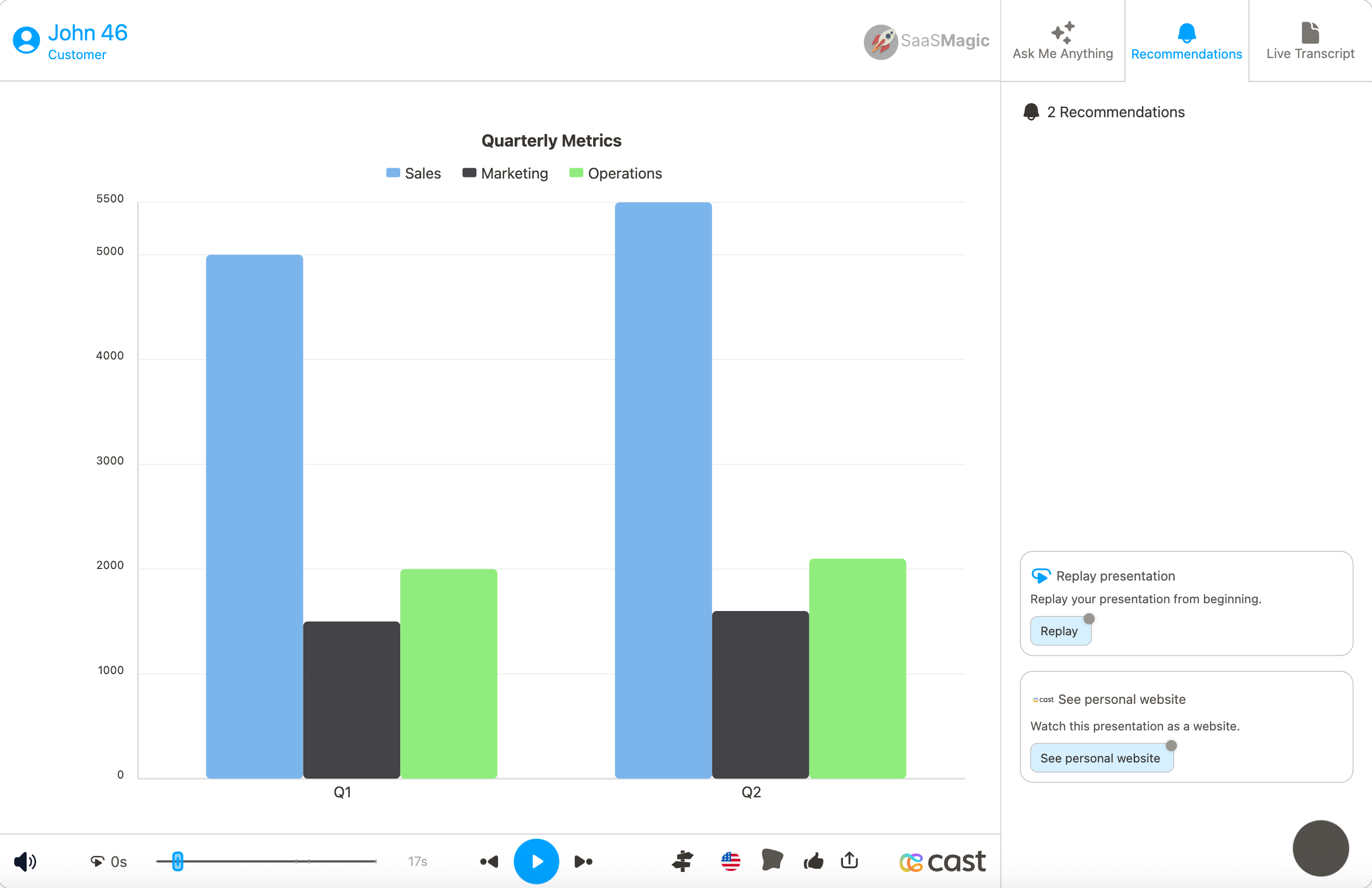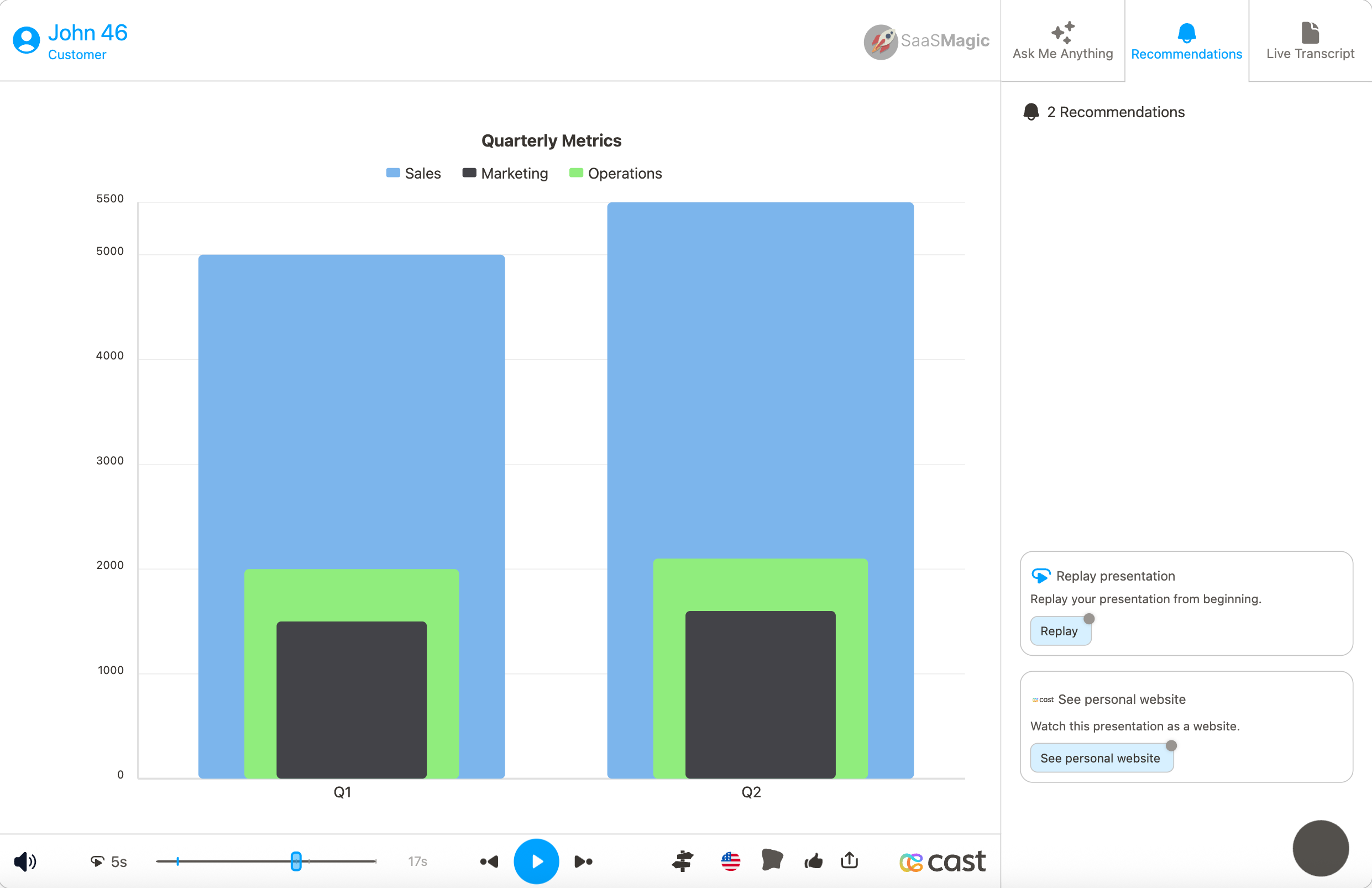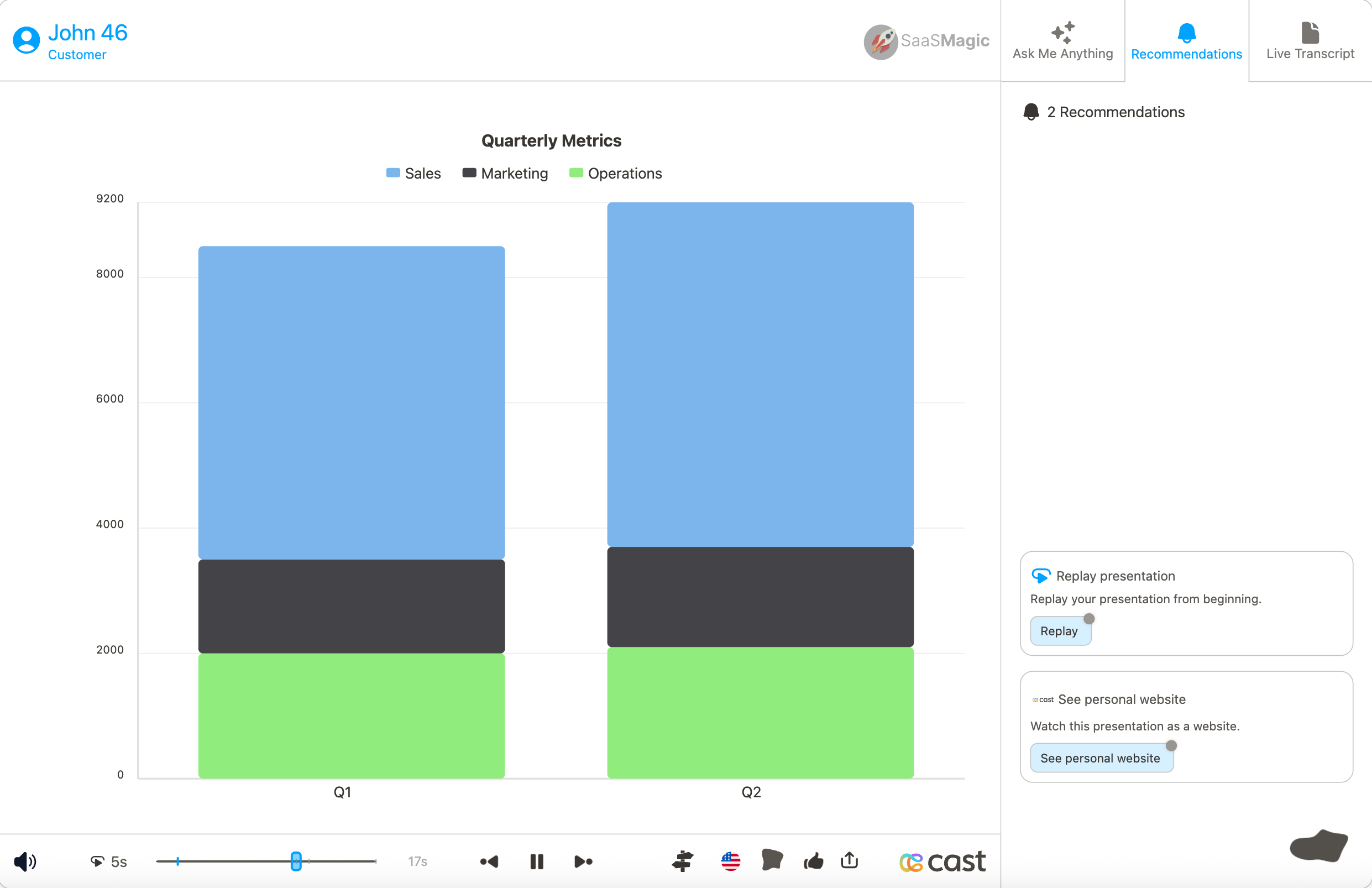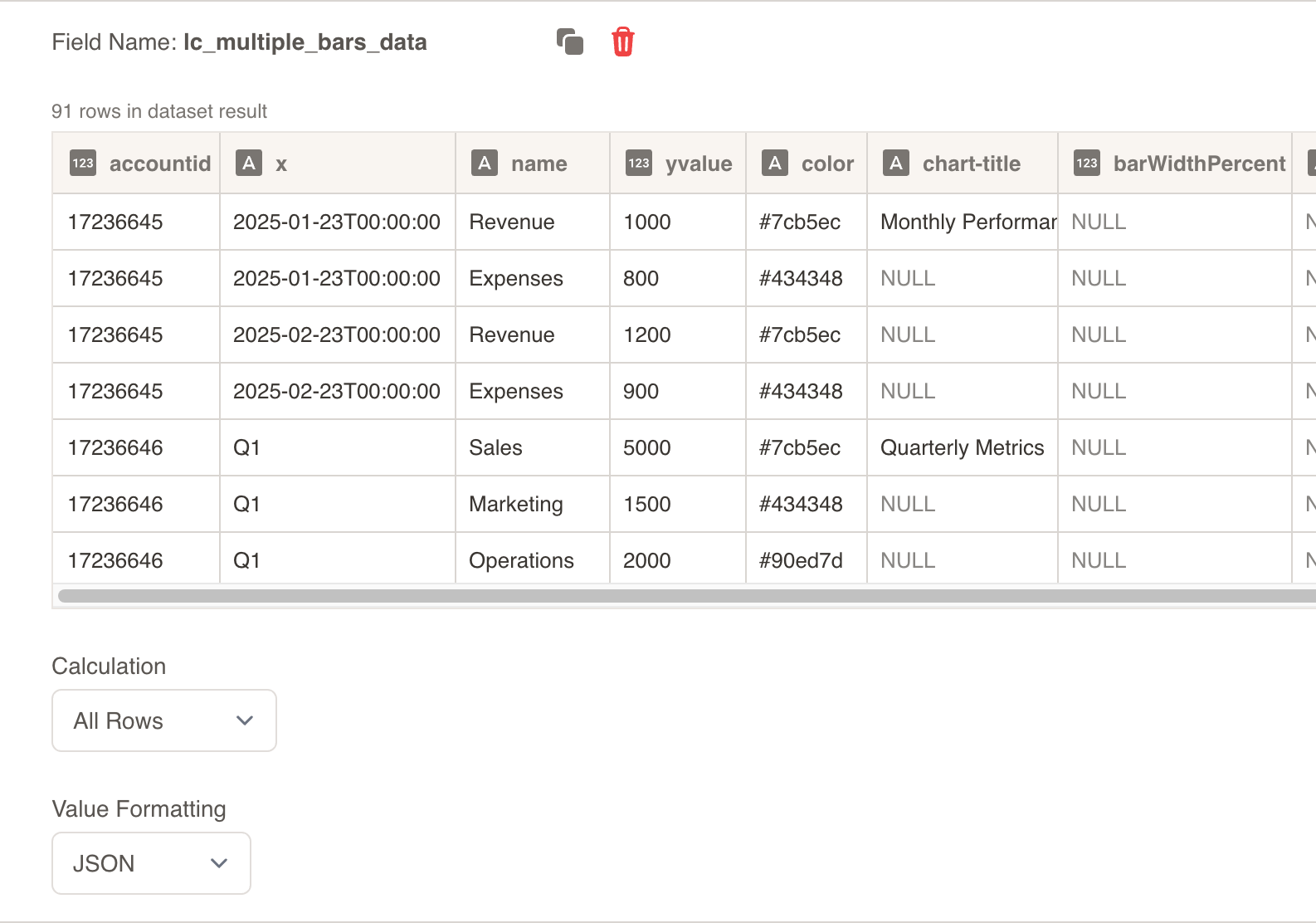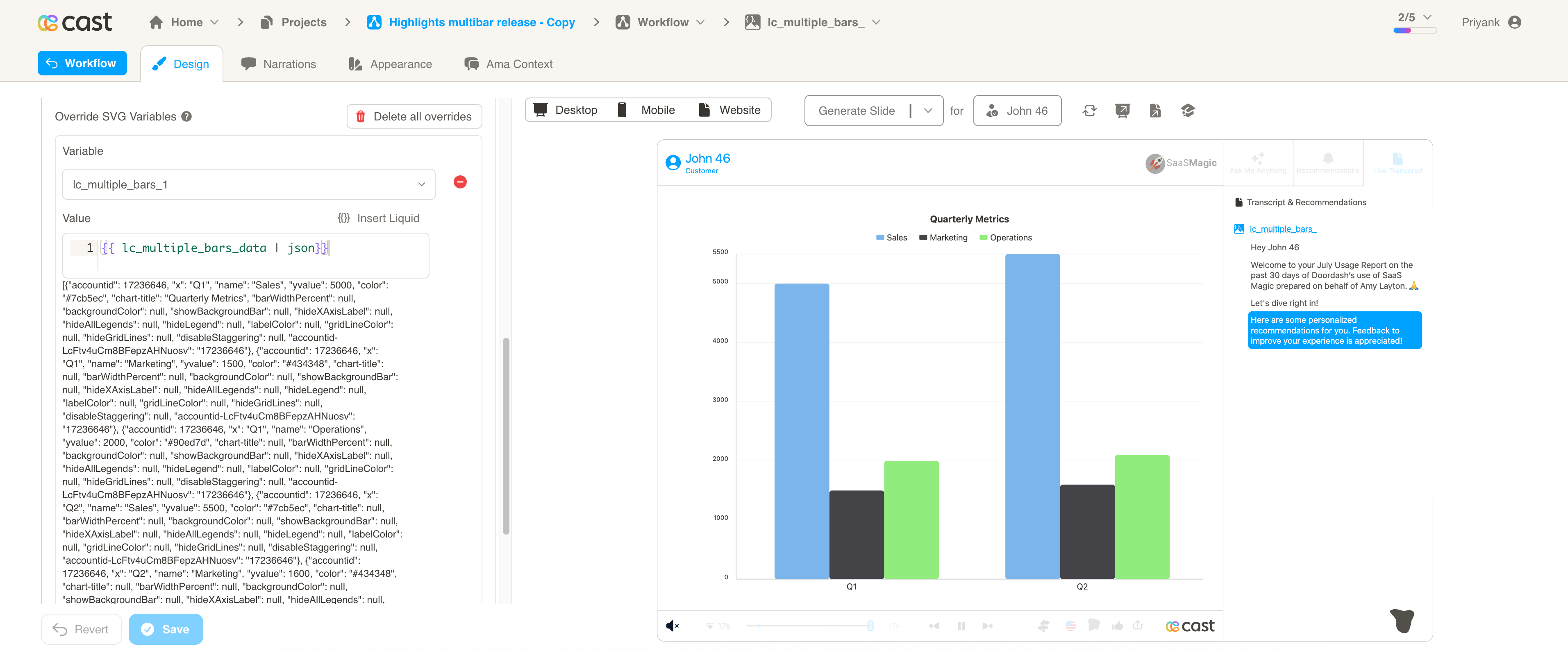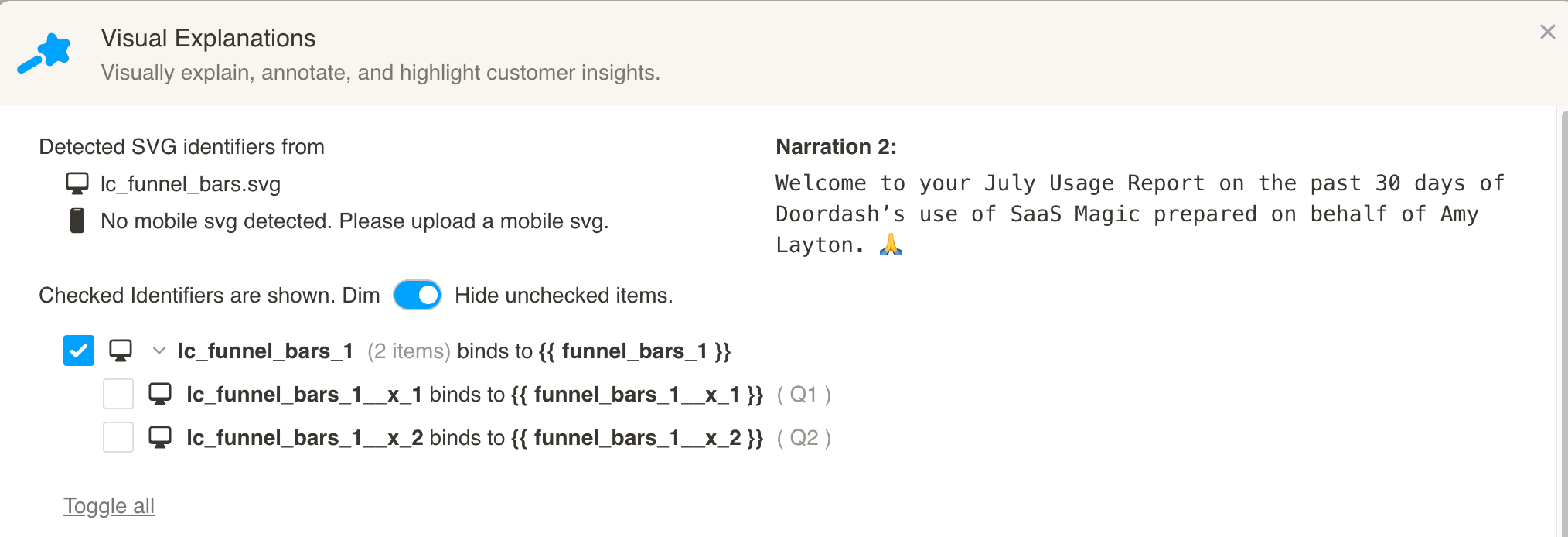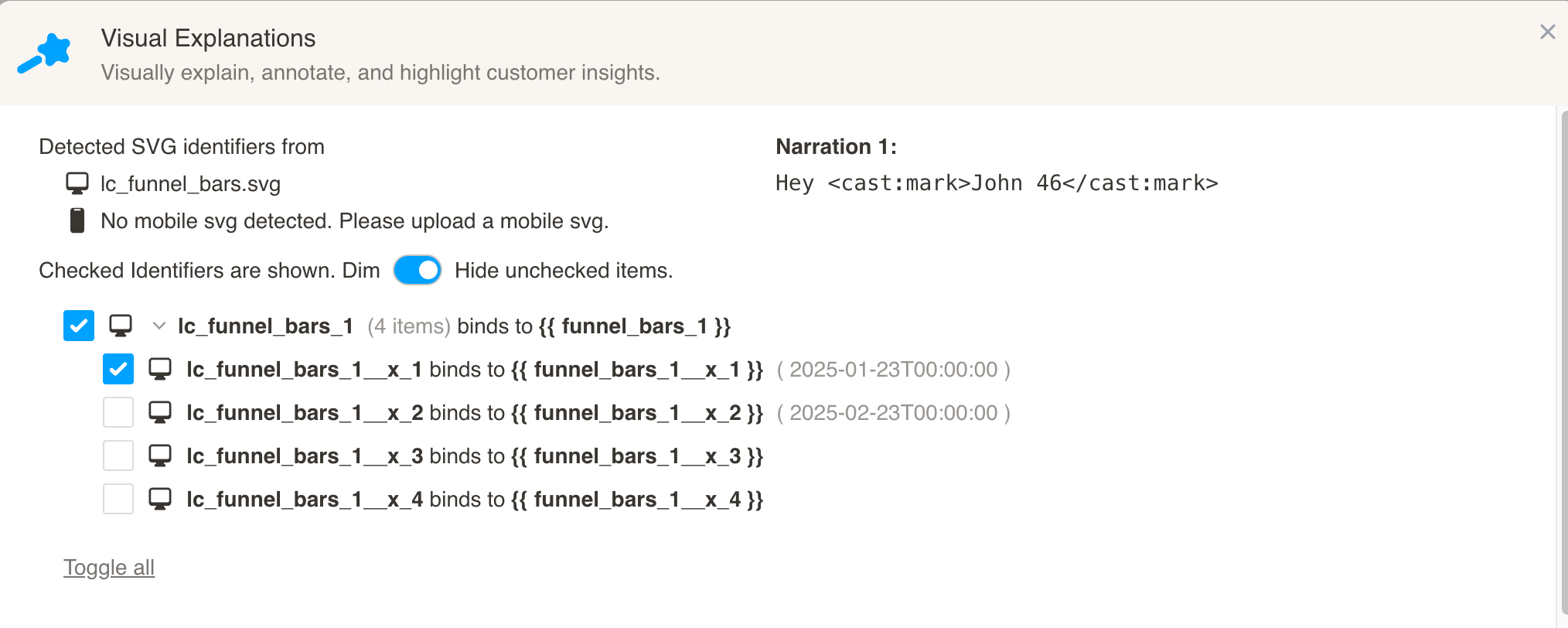Interactive Bar Chart Visualization with lc_multiple_bars_*, lc_funnel_bars_*, lc_stacked_bars_*
The bar chart components provide comprehensive interactive bar chart visualization with three distinct display modes. These components include advanced features like animated bar growth, interactive legends, tooltips, and responsive design, making them perfect for comparative analysis, hierarchical data visualization, and part-to-whole relationships.
- lcmultiple_bars*: Series displayed side-by-side within each category for direct comparison
- lcfunnel_bars*: Series displayed as concentric bars (largest to smallest) for hierarchical relationships
- lcstacked_bars*: Series stacked vertically to show cumulative totals and part-to-whole relationships
Use Cases
lcmultiple_bars*:
- Quarterly revenue vs expenses comparison
- Department performance metrics side-by-side
- Product sales comparison across regions
- Multi-metric dashboards and scorecards
- Year-over-year performance analysis
lcfunnel_bars*:
- Budget vs actual vs target visualization
- Hierarchical organizational data
- Nested category analysis
- Contained value relationships
- Multi-level performance indicators
- Concentric data comparisons
lcstacked_bars*:
- Revenue breakdown by product lines
- Time allocation across projects
- Market share composition
- Budget allocation visualization
- Cumulative performance metrics
- Part-to-whole relationship analysis
Element Identification
The target element must be a <rect> with an ID that starts with one of:
lc_multiple_bars_*for grouped column charts (side-by-side comparison)lc_funnel_bars_*for nested column charts (concentric bars)lc_stacked_bars_*for stacked column charts (cumulative totals)
Input Format
The input value must be provided as a JSON array of objects with the following structure:
JSON Format
A JSON string containing an array of objects with the following structure:
[
{
"x": "Q1",
"name": "Revenue",
"yvalue": 1000,
"color": "#7cb5ec",
"chart-title": "Quarterly Performance"
},
{
"x": "Q1",
"name": "Expenses",
"yvalue": 800,
"color": "#434348"
},
{
"x": "Q2",
"name": "Revenue",
"yvalue": 1200,
"color": "#7cb5ec"
},
{
"x": "Q2",
"name": "Expenses",
"yvalue": 900,
"color": "#434348"
}
]
Dataset/CSV Format
Alternatively, you can use tabular data from your datasets with the following columns:
| x | name | yvalue | color | chart-title | hideGridLines | barWidthPercent |
|---|---|---|---|---|---|---|
| Jan | Sales | 850 | #7cb5ec | Monthly Performance | - | - |
| Jan | Profit | 320 | #434348 | - | - | - |
| Feb | Sales | 920 | #7cb5ec | - | - | - |
| Feb | Profit | 380 | #434348 | - | - | - |
| Mar | Sales | 1150 | #7cb5ec | - | - | - |
| Mar | Profit | 450 | #434348 | - | - | - |
Advanced Example with Custom Settings:
| x | name | yvalue | color | chart-title | backgroundColor | barWidthPercent | hideXAxisLabel |
|---|---|---|---|---|---|---|---|
| Team A | Score | 85 | #f15c80 | Team Performance | #ffe6f0 | 60 | - |
| Team B | Score | 92 | #f15c80 | - | #ffe6f0 | 60 | - |
| Team C | Score | 78 | #f15c80 | - | #ffe6f0 | 60 | - |
Complex Multi-Series Example:
| x | name | yvalue | color | backgroundColor | barWidthPercent | hideLegend | hideXAxisLabel | labelColor | gridLineColor |
|---|---|---|---|---|---|---|---|---|---|
| Q1 2023 | Revenue | 125000 | #3498db | #ecf0f1 | 40 | - | - | #2c3e50 | #bdc3c7 |
| Q1 2023 | Profit | 28000 | #27ae60 | #d5f4e6 | 40 | - | - | - | - |
| Q1 2023 | Internal Costs | 15000 | #e74c3c | - | 20 | true | - | - | - |
| Q2 2023 | Revenue | 142000 | #3498db | #ecf0f1 | 40 | - | - | - | - |
| Q2 2023 | Profit | 35000 | #27ae60 | #d5f4e6 | 40 | - | true | - | - |
| Q2 2023 | Internal Costs | 18000 | #e74c3c | - | 20 | - | - | - | - |
Additional Property Examples:
| x | name | yvalue | hideAllLegends | disableStaggering | showBackgroundBar | totalXSeries | highlightColor |
|---|---|---|---|---|---|---|---|
| 2019 | Growth | 15.5 | true | - | false | - | - |
| 2020 | Growth | -2.3 | - | - | - | - | #ff6b6b |
| 2021 | Growth | 8.7 | - | true | - | 4 | - |
Dataset Usage:
- Connect your column chart to a dataset containing the required columns
- The system will automatically map the columns to the appropriate chart properties
- Filter data by categories or time ranges to show relevant comparisons
- Multiple rows create comprehensive multi-series column visualizations
Important Notes:
- Column names must match exactly as shown in the example (
x,name,yvalue,color, etc.) - Column names are case-sensitive and must be spelled exactly as specified
- If data is not passed in the correct format or column names don’t match, the element will display as a plain
<rect>without any chart visualization - Series limit is capped at 10 to maintain chart readability and performance
- Negative values are automatically clamped to 0 for proper visualization
Implementation Steps for Dataset Usage
To use dataset/CSV format with column charts, follow these steps:
Create Dataset: Import your data containing the required columns (x, name, yvalue, and optional styling columns)
Create Field: Create a field from your dataset that contains the column chart data
Set Value Formatting: In the field settings, set Value Formatting to “JSON” - this is crucial for proper data formatting
Override SVG Variables: In the SVG slide design tab, go to “Override SVG Variables”
Select Variable: Choose your column chart variable and use the format with your field
Include JSON Filter: Critical: Always include the | json filter with your field, otherwise the column chart will not work
Automatic Highlights Variable Generation
When you create SVG elements with lcmultiple_bars, lc*funnel_bars*, lcstacked_bars*, the designer automatically generates corresponding variables:
- Generates highlighting variables with
__x_prefix for each category
Highlighting Variables:
For lcmultiple_bars*:
lc_multiple_bars_1 (2 items) →
lc_multiple_bars_1__x_1 → (Q1)
lc_multiple_bars_1__x_2 → (Q2)
For lcfunnel_bars*:
lc_funnel_bars_1 (2 items) →
lc_funnel_bars_1__x_1 → (Q1)
lc_funnel_bars_1__x_2 → (Q2)
For lcstacked_bars*:
lc_stacked_bars_1 (2 items) →
lc_stacked_bars_1__x_1 → (Q1)
lc_stacked_bars_1__x_2 → (Q2)
totalXSeries Control
When totalXSeries is defined in your data, the designer creates that exact number of highlighting variables:
Example with totalXSeries: 4
{
"x": "Q1",
"name": "Revenue",
"yvalue": 1000,
"totalXSeries": 4
}
Generated Variables:
lc_multiple_bars_1__x_1 → (Q1)
lc_multiple_bars_1__x_2 → (Q2)
lc_multiple_bars_1__x_3 →
lc_multiple_bars_1__x_4 →
This ensures consistent variable availability even if your data doesn’t include all categories yet.
💡 Bonus Tip: You can determine the optimal totalXSeries value by querying your data:
SELECT COUNT(DISTINCT category) as unique_category_count
FROM your_table_name;
Use this count as your totalXSeries value to ensure all categories have corresponding highlighting variables.
Data Field Requirements
All chart types use the same data structure, but the designer optimizes the visualization based on the element type:
Required Fields:
x: Category labelsname: Series namesyvalue: Numeric values
Optional Fields:
- All styling and configuration properties work across all chart types
- Some properties (like
showBackgroundBar) are optimized for specific chart types
Configuration Properties
Required Properties
x: Category label for x-axis (string, mandatory)name: Series identifier/name (string, mandatory)yvalue: Numeric value for the data point (number, mandatory, negative values clamped to 0)
Optional Chart-Level Properties (taken from first occurrence)
chart-title: Title displayed at the top of the chart (string, optional)
Optional Series-Level Properties (taken from first occurrence of each series)
| Property | Type | Description |
|---|---|---|
color | string | Color for this series (hex code or color name) |
backgroundColor | string | Background color for this series |
highlightColor | string | Color for category highlighting borders |
barWidthPercent | number | Width as percentage of available space |
hideAllLegends | boolean | Hide all legend items |
hideLegend | boolean | Hide legend for this specific series |
labelColor | string | Color for legend text of this series |
hideGridLines | boolean | Hide all grid lines |
gridLineColor | string | Override grid line color |
Optional Global Settings (taken from first data object)
| Property | Type | Description |
|---|---|---|
disableStaggering | boolean | Prevent automatic label staggering |
showBackgroundBar | boolean | Show/hide background bars (default: true, only for lcmultiple_bars*) |
labelColor | string | Global color for all chart labels and text |
totalXSeries | number | Define number of axis points for highlighting (overrides data calculation) |
Optional Per-Category Settings (checked for each x-value)
| Property | Type | Description |
|---|---|---|
hideXAxisLabel | boolean | Hide the x-axis label for this specific category |
Technical Implementation
Dynamic Text Fitting
- Width-Based Truncation: Labels are truncated based on actual bar width, not fixed character limits
Data Structure Assumptions
Data Assumptions
- X-axis values are categorical (strings) and represent distinct categories
- Y-axis values are numeric and non-negative (negative values are clamped to 0)
- Series limit is capped at 10 to maintain chart readability and performance
- Missing values are treated as 0 in calculations and display
- Chart title is optional but when provided, affects legend positioning
Display Assumptions
- Minimum bar width is 1px to ensure visibility
- Default colors cycle through a predefined palette when series exceed color count
- Font family is extracted from the global story metadata (
fontHint) - Text color is derived from the current chart’s image text color setting
- Container dimensions are expected to be reasonable (minimum 100x100px)
Interaction Assumptions
- Background bars are shown by default unless explicitly disabled (lcmultiple_bars* only)
Best Practices
- Ensure consistent series names across all categories
- Use meaningful category labels that fit within available space
- Provide colors for series to maintain consistent branding
- Keep series count under 10 for optimal performance
- Include
highlightColorproperties for categories you plan to emphasize - Use
totalXSerieswhen you need precise control over highlighting variables
